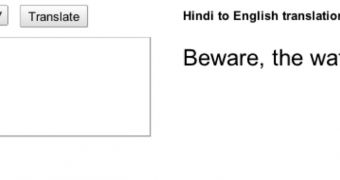Google Translate is introducing a subtle but important new feature, the possibility to alter the translation on the fly and pick the best version from several options for each of the words translated. You can enter your own version if the ones listed aren't accurate. The feature also gives a glimpse at how the technology behind Google Translate works.
"Sometimes translation can be pretty tough. Language is full of ambiguities and our system has to do its best to make the right choices. So why choose?," Josh Estelle, Senior Software Engineer at Google, writes.
"We’ve launched a new feature to provide you with alternate translations for each phrase in the translated text. Just click the translated phrase and you’ll see a pop-up menu of possible alternates for that phrase, as well as the original phrase highlighted in your original text," he explains.
Hover over any translated word and you will not only see the original word, or words, to which it relates, but also alternative translations. If you think something just doesn't sound right, you can click on the word for a drop-down list of other versions. You can also enter your own translation.
This way, there is a great chance that one of the alternates makes a lot more sense in the context and you'll get a much better translation in the process. What's more, you'll also be helping Google do a better job next time.
"Not only can these alternative translations give you a better understanding of a confusing translation, but they also allow you to help Google choose the best alternative when we make a mistake," Estelle explains.
Google Translate uses a statistical machine translation system. Google's computers scours through vast data sources and look for translations of words, phrases and so on.
When it's translating something, the system looks through its vast data set and finds the version that is the most likely, based on sheer number. It's not a perfect system, as anyone who has used Translate will know, but the beauty of it is that it gets better in time.
So any time you make a correction, your input is added and weight against the data already available. This way, little by little, Google Translate will become more accurate.

 14 DAY TRIAL //
14 DAY TRIAL //